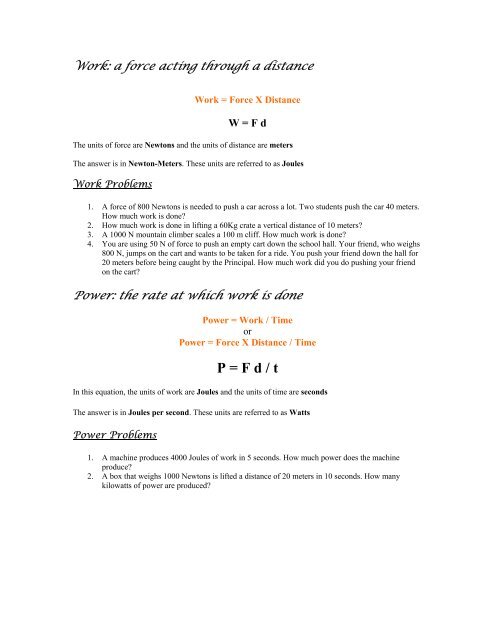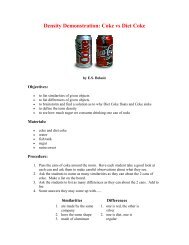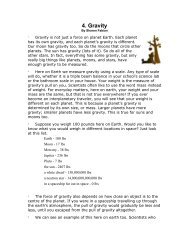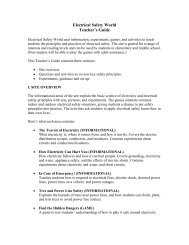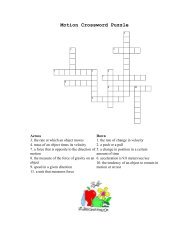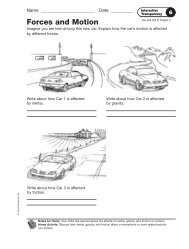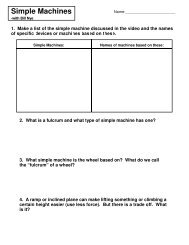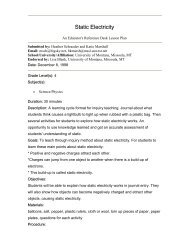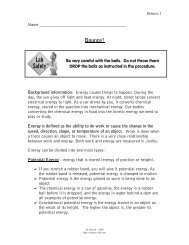Work: a force acting through a distance
Work: a force acting through a distance
Work: a force acting through a distance
- No tags were found...
Create successful ePaper yourself
Turn your PDF publications into a flip-book with our unique Google optimized e-Paper software.
<strong>Work</strong>: a <strong>force</strong> <strong>acting</strong> <strong>through</strong> a <strong>distance</strong><strong>Work</strong> = Force X DistanceW = F dThe units of <strong>force</strong> are Newtons and the units of <strong>distance</strong> are metersThe answer is in Newton-Meters. These units are referred to as Joules<strong>Work</strong> Problems1. A <strong>force</strong> of 800 Newtons is needed to push a car across a lot. Two students push the car 40 meters.How much work is done?2. How much work is done in lifting a 60Kg crate a vertical <strong>distance</strong> of 10 meters?3. A 1000 N mountain climber scales a 100 m cliff. How much work is done?4. You are using 50 N of <strong>force</strong> to push an empty cart down the school hall. Your friend, who weighs800 N, jumps on the cart and wants to be taken for a ride. You push your friend down the hall for20 meters before being caught by the Principal. How much work did you do pushing your friendon the cart?Power: the rate at which work is donePower = <strong>Work</strong> / TimeorPower = Force X Distance / TimeP = F d / tIn this equation, the units of work are Joules and the units of time are secondsThe answer is in Joules per second. These units are referred to as WattsPower Problems1. A machine produces 4000 Joules of work in 5 seconds. How much power does the machineproduce?2. A box that weighs 1000 Newtons is lifted a <strong>distance</strong> of 20 meters in 10 seconds. How manykilowatts of power are produced?
Machines make work easier by changing the size ordirection of a <strong>force</strong>.2 <strong>force</strong>s are always involved when using a machine1. Resistance Force - F R -the <strong>force</strong> applied by a machine2. Effort Force - F E - the <strong>force</strong> applied to a machine<strong>Work</strong> is done to a machine as well as by a machine1. <strong>Work</strong> Output - W O - the work done by a machine2. <strong>Work</strong> Input - W I - the work done on a machineWhen using a machine, <strong>distance</strong>s are not the same1. Effort Distance - d E - the <strong>distance</strong> <strong>through</strong> which the machine moves2. Resistance Distance - d R - the <strong>distance</strong> the object movesMechanical Advantage: the number of times amachine multiplies the effort <strong>force</strong>.Mechanical Advantage = Resistance Force / Effort ForceMA = F R / F EMA is equal to 1 - the machine is used to change the direction of the effort <strong>force</strong>.MA is less than 1 - the machine is used to increase the <strong>distance</strong> an object moves or thespeed at which it moves.MA is greater than 1 - the machine is used to increase the effort <strong>force</strong>.Efficiency: a comparison of work output to work inputEfficiency is always expressed as a percentage<strong>Work</strong> output is never greater than work input.
Efficiency = <strong>Work</strong> Output / <strong>Work</strong> Input X 100Mechanical Efficiency ProblemsEfficiency = W O / W I X 1001. What does friction do to the efficiency of a machine?2. You use a pair of pliers to crack a pecan. It takes 1200 N of resistance <strong>force</strong> to crack the pecan, butyou only exert 400 N of effort <strong>force</strong> with your hand on the pliers. What is the mechanicaladvantage of the pliers?3. Think of pliers as a pair of first-class levers. The fulcrum about which the levers turn is located atpoint B. The lever arm represented by the line AB is 6 cm long. The lever arm represented by lineBC is 3 cm long. What is the mechanical advantage of this set of pliers?- adapted from www.middleschoolscience.com


